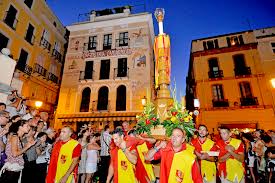FEAST SANCTA MARIA OF MEZO GOSTO – IGLESIAS – WEDNESDAY AUGUST 15
Feast of Sancta Maria di Mezo of Gosto Iglesias, August 15 “Sancta Maria del Mezo Gosto Month”, an ancient and famous festival in honor of the Assumption Iglesias, is described, with regard to the offering of candles and other customs in the “Short Villa of the Church “, an ancient code of laws which governed life in the city of Iglesias, of the thirteenth century. A celebration is very important from religious point of view and from that town. To understand the origin of the cult of the Virgin of the Assumption is necessary to go back to the era of ancient Romans. In those days, in August, the Latins were celebrating the feriae consuali, feasts in honor of the god Consus, god job-related fields and the abundance of the harvest. Under the emperor Augustus became the holidays consuali feriae august. Then the big party land, magical and propitiatory, with the arrival of Christianity, was replaced with the worship in honor of the Virgin. The Feast of the Assumption is perhaps the oldest of the Marian feasts and his cult of oriental origin, was already widespread in the sixth century AD throughout the Byzantine church under the name in greek for “Dormition of the Mother of God”, the koimesis. As reported in the Brief of Villa Church, through the City was committed to the great feast to Our Lady: the highlights were the offer of eight large candles to the Virgin, by the Municipal Authority, the Districts and Corporations, and release of some prisoners, especially women.
The Association of Candlesticks BV Assumption was founded in 1993 with the Statute approved on March 25, 1996 by His Bishop Arrigo Miglio Ecc.za Rev.mo, then Bishop of Iglesias.
From “Short Villa Church” XIII Century:
“And when they dicti moveranno it passes from the dicta (Court Square) to go to decta Ecclesia Sancta Clara, inantse go to the University, apresso de la Montagne, apresso to Sancta Clara, apresso to Mezo, apresso to Fontana, apresso to Castles, apresso Vinajuoli of them, what apresso et de ‘Workers: and so they batter in the Sancta Clara. “
On November 1, 1950 (Holy Year) Pius XII proclaimed the dogma of faith the Assumption of Mary into heaven in body and soul. Such a solemn dogmatic definition was preceded by an extensive consultation extended to all the bishops of the world. The outcome was surprising: the Church has always believed and professed that the Holy Mother of God “was raised body and soul into heavenly glory, which shines as Queen at the right of His Son, the immortal King of ages” (Dogmatic Constitution Munificentissimus Deus). The Bishops of Sardinia, in answer to the Pope on the faith of Sardis, became the pride of the ancient tradition Iglesias, inserted in the Charter of the City, whose four doors are, among other things, consecrated to the Virgin Mary. The great historical tradition, with the participation of the Candlestick, begins to take shape in 1992, when it is found in a closet adjoining the House Chapter of the column that had been a candlestick. This was skillfully restored by a craftsman of Iglesias and positioned in the Candlestick in the neighborhood of Santa Chiara which probably came from. While Sassari has nine candlesticks, each with a referent Gremio, our City has eight (ninth, 1500, relative to the goldsmiths and silversmiths Gremio has yet to achieve) but with a particular connotation that differs markedly from Sassari University Villa, four Historic Districts and four Guilds and Corporations.
In “Short” three chapters are devoted to the celebration of “Santa Maria di mezo ugust” with different rules to be observed, among which one is referring to the liberation of prisoners, men and women, on the day of the Assumption. The candles were so large that they stay on for a whole year and no one could undo them, on pain of having to pay 10 pounds of alfonsini minutes.
The stanchions are four feet tall and need for the transportation of 16-20 people.
- Candlestick University of Villa
With four panels depicting the main activities of Iglesias: mining, pastoralism, agriculture, handicrafts. There are four bronze statues symbolizing the cardinal virtues: justice, prudence, fortitude, temperance.
- Candlestick Gremio of the Mountain
The panels represent St. Barbara, B.V. Assumption, a Roman coin of 45-15 BC mining and medieval scenes.
- Candlestick District of Santa Clara
The panels represent St. Clare, the Virgin Mary’s Assumption and Monograms.
- Candle in the neighborhood “Mezo”
The panels represent a glimpse of the neighborhood Roman camp, San Saturn and his Church, now the Shrine of Our Lady of Grace, BV Assumption.
- Candle in the neighborhood of Fontana
The panels are some pictures and scenes of the Old Town of medieval Iglesias: square with a fountain, a porch, a clerk, St. Nicholas, Our Lady of Bangiargia.
- Candlestick of the Castle District
Reliefs with symbols and views typical of the neighborhood: a hawk, a dove, a soldier, the arms of Pisa, an eagle, Is grifoneddus.
- Candlestick of Gremio of Vinajuoli, Tavernai, Shoemakers
The panels show the images S.Isidoro, the Byzantine Church SS. Savior, B.V. Assumption and agricultural symbols.
- Candlestick Workers of the Gremio-artisans of panels depicting Saints protected arts and crafts: St. Eligius, St. Philomena, St. Ermenegildo, St. Crispin, St. Joseph.
Leave a Comment
You must be logged in to post a comment.




